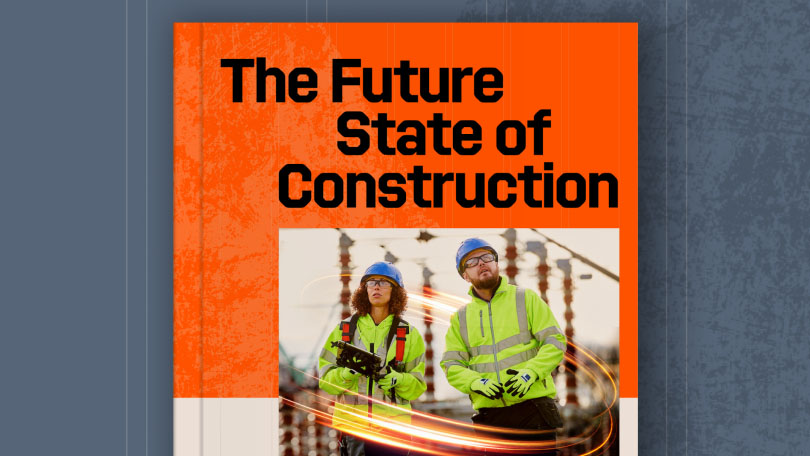— 7 min read
How Construction Project Management Drives Project Success

Last Updated Sep 15, 2025

Nicholas Dunbar
Content Manager
62 articles
Nick Dunbar oversees the creation and management of UK and Ireland educational content at Procore. Previously, he worked as a sustainability writer at the Building Research Establishment and served as a sustainability consultant within the built environment sector. Nick holds degrees in industrial sustainability and environmental sciences and lives in Camden, London.
Last Updated Sep 15, 2025

Construction is widely acknowledged as one of the most complex and rapidly evolving industries in the world. Beyond bricks and mortar, it calls for precision planning, close coordination, and expert oversight, from the first day on site to the final handover. Construction project management is the driving force behind delivering complex builds safely, efficiently, and to a consistently high standard.
Understanding project management in construction involves knowing what the process includes, how it all comes together, and why it’s essential for successful outcomes – a project delivered on time and on budget.
Table of contents
What is Project Management in Construction?
Construction project management is the structured process of planning, coordinating, and overseeing a construction project from start to finish. When carried out effectively, this process turns architectural and engineering plans into physical structures, with maximum efficiency. Regardless of project size or scope, construction project management brings together people, materials, equipment, and timelines to complete a project with efficiency, precision, and control. The process typically covers:
- Defining the scope of the project and setting clear objectives
- Creating detailed timelines and schedules to manage activities and dependencies
- Allocating and managing resources like labour, equipment, and materials
- Controlling costs and monitoring budgets throughout the build
- Managing communication across teams and stakeholders
- Monitoring progress and adapting plans to avoid delays or risks
Construction project managers are central to this entire process. Their work involves checking that each stage – from groundwork to handover – is properly managed and aligned with the project’s strategic goals.
Key Responsibilities of a Construction Project Manager
A construction project manager plays a fundamental role in guiding a project from concept to completion. In addition to monitoring day-to-day site activity, they’re responsible for checking that every element of the build is aligned with the project’s goals. Key construction project manager duties include:
- Planning and Scheduling: Creating detailed work programmes, setting timelines, and allocating tasks across teams and subcontractors
- Resource Management: Making sure the right materials, labour, and equipment are available when needed to avoid delays or cost overruns
- Budget Control: Monitoring costs, managing contracts, and keeping the project within its financial limits
- Risk Management: Identifying potential risks – such as health and safety issues, delivery delays, or design changes – and developing mitigation strategies
- Quality Assurance: Making sure all work meets the specified standards and regulatory requirements
- Communication and Coordination: Acting as the link between stakeholders – including clients, architects, engineers, and site teams – to keep everyone aligned
- Handover and Close-out: Overseeing final inspections, documentation, and transition to the client or facilities team
In addition to the build itself, a skilled project manager plays a key role in managing expectations, avoiding disputes, and driving overall project success.
Importance of Construction Project Management
Construction projects are high-value, high-stakes endeavours. Without effective project management in place, costs can spiral, deadlines can slip, and quality can suffer. That’s why construction project management isn’t just a support function but a key driver of project success.
By setting a clear direction and maintaining control throughout the project lifecycle, construction project management helps teams:
- Stay on budget: Through effective cost planning, close monitoring of spending, and early identification of potential overruns, project managers help protect margins and avoid financial surprises.
- Deliver on time: With detailed scheduling, real-time progress tracking, and the ability to respond quickly to on-site changes, timelines are more easily controlled – even when challenges arise.
- Maintain quality and compliance: Quality assurance processes, regular inspections, and adherence to construction standards and building regulations enable the final build to meet stakeholder expectations and legal requirements.
- Mitigate risk: From health and safety concerns to supply-chain disruptions or design changes, project managers identify risks early and implement mitigation strategies before they escalate.
- Align stakeholders: Consistent communication and structured reporting keep all parties informed and engaged – from clients to subcontractors – reducing friction and promoting transparency and collaboration.
The Construction Project Lifecycle
Every construction project passes through a series of distinct phases, starting from the initial concept through to the final handover. Together, these stages form the construction project lifecycle.
Each phase requires a different set of skills and focus areas from the project manager, who guides the process through each of the below stages:
- Initiation: This stage involves defining the project's objectives, evaluating feasibility, and establishing the scope. Project managers may support procurement of land, appoint key consultants, and begin forming the project brief.
- Planning: One of the most vital phases, planning sets the groundwork for everything that follows. It involves developing detailed timelines, budgets, and resource plans, identifying risks, and selecting suppliers and contractors.
- Execution: This is when work begins on site. The project manager oversees construction activity, manages workflows, guarantees compliance with safety standards, and handles on-the-ground problem-solving.
- Monitoring and Controlling: These tasks run in parallel with execution. Project managers track performance against KPIs, manage change requests, provide quality assurance, and adjust plans as needed to keep the project on track.
- Closure: The final phase involves inspections, snagging, formal handover to the client, and administrative close-out, such as documentation and certifications.
Tools and Technologies in Construction Project Management
Digital tools are reshaping how construction projects are planned, managed, and delivered, turning complex workflows into coordinated, real-time operations. Some of the most widely used construction project management tools include:
- Project management platforms: These cloud-based systems provide a central hub for scheduling, budgeting, task-tracking, and document management, enabling real-time collaboration between site teams, office staff, and stakeholders.
- Building Information Modelling (BIM): BIM provides a detailed 3D information model; when coupled with real-time sensor data it can form the basis of a digital twin, enhancing coordination between disciplines, enabling clash detection and improved accuracy during planning and construction. It’s particularly valuable for large or complex builds.
- Scheduling and planning software: Tools such as Gantt charts, 4D simulation, and critical path method (CPM) software help project managers visualise timelines, allocate resources, and manage dependencies.
- Mobile apps and field tools: Smartphones and tablets allow site teams to log updates, access drawings, flag snags, and conduct inspections directly from the field, reducing delays and improving accuracy.
- Data analytics and reporting tools: Dashboards, forecasting tools, and KPI tracking give project managers the insights they need to make informed decisions and demonstrate progress to stakeholders.
As the industry continues to embrace digital transformation, integrating these technologies has become central to project management today.
Project Management in Construction: The Challenges
Construction project management comes with challenges rarely found in other industries. Projects unfold on live sites, often in unpredictable environments, with complex supply chains and logistical challenges that demand fast, informed decision-making. Unlike office-based project management, construction requires handling logistical hurdles, fluctuating material costs, and on-the-ground decision-making, often all at once. Project managers in construction also deal with:
- Diverse on-site teams working across multiple disciplines, often under tight timelines
- Strict regulatory frameworks, including the Construction (Design and Management) Regulations 2015 (CDM 2015), which assign legal duties to those managing and planning the work
- Safety-critical environments, where risk management and compliance are as vital as cost or scheduling
- Dynamic site conditions, including unexpected design changes, weather disruption, or material shortages
This adds a layer of complexity that sets construction project management apart from office-based or digital project environments.
Construction Management vs Construction Project Management
While the terms are often used interchangeably, construction management and construction project management refer to distinct roles, each with its own focus, scope, and responsibilities.
Construction project management is a broader discipline that covers the entire project lifecycle, from initial planning and procurement through to execution and the final handover. Project managers coordinate multiple teams, juggle budgets, track timelines, and manage risk to deliver the project on budget and to specification. They’re also responsible for regulatory compliance – yet another layer of accountability that requires a keen eye for detail.
Construction management is typically more hands-on and site-focused – supervising subcontractors, managing materials, and ensuring health and safety protocols are followed. Their job is to keep operations running smoothly on the ground.
Both roles are essential, but they serve different purposes: one keeps the whole project aligned from above, while the other makes sure that the boots-on-the-ground delivery happens safely and efficiently.
Construction project management is the cornerstone of a successful build. It provides the structure, strategy, and oversight needed to turn complex plans into tangible results. A good project manager coordinates smoothly and aligns diverse teams around shared goals, keeping every phase of the project on track. They juggle multiple variables, from compliance to cutting-edge technology, shaping the built environment one decision at a time, for consistently successful projects.
Categories:
Written by

Nicholas Dunbar
Content Manager | Procore
62 articles
Nick Dunbar oversees the creation and management of UK and Ireland educational content at Procore. Previously, he worked as a sustainability writer at the Building Research Establishment and served as a sustainability consultant within the built environment sector. Nick holds degrees in industrial sustainability and environmental sciences and lives in Camden, London.
View profileExplore more helpful resources

Control the Chaos: Standardising Document Workflows in Construction Projects
Document control and implementation play a central role in managing risk, meeting deadlines, and delivering projects to spec. As builds become more complex and teams increasingly disperse, the volume and...

Cost-Plus Construction Contracts in the UK
A construction cost-plus contract – sometimes called a cost-reimbursable or prime cost contract – reimburses all project costs and adds a fee to cover the contractor’s overhead and profit. UK...

Digital Construction Technology for Whole-Life Value
For decades, the construction industry has kept a narrow focus on capital cost — the one-time, upfront costs of a construction project. While in the short term this seems like...

UK Construction Progress Reports: Tools for Smarter Site Management
Construction progress reports track completed work, on site issues, costs, and safety so UK project teams can demonstrate progress, secure payments, and stay on programme. Accurate progress data is essential...
